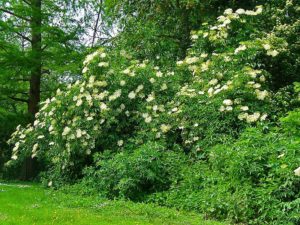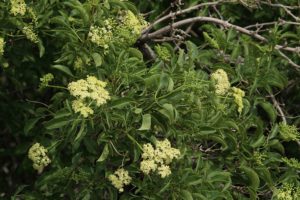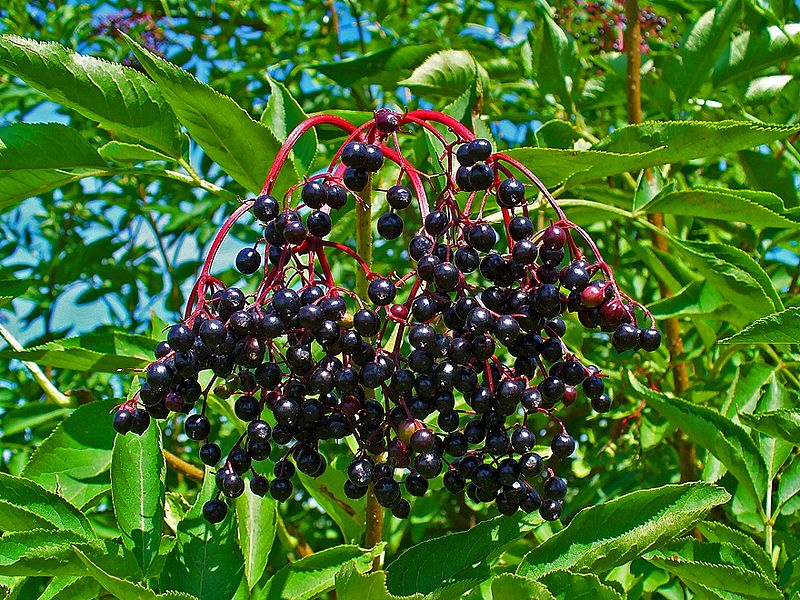 Elderberry (Sambucus spp) is a deciduous shrub with species that are native all over the world. The traditional species used medicinally is S. nigra, the black elderberry, which is native to Europe. Here in the US, home to several native species, it is S. Canadensis, the American elderberry, native to Eastern North America that is occasionally used medicinally. It is most frequently used in the landscape, often planted on stream banks for erosion control thanks to its habit of rapidly spreading via suckers. It is also popular in landscapes designed to attract wildlife. Birds love the berries. The flowers attract butterflies, bees and hummingbirds. Historically, Native Americans used the flowers and berries medicinally.
Elderberry (Sambucus spp) is a deciduous shrub with species that are native all over the world. The traditional species used medicinally is S. nigra, the black elderberry, which is native to Europe. Here in the US, home to several native species, it is S. Canadensis, the American elderberry, native to Eastern North America that is occasionally used medicinally. It is most frequently used in the landscape, often planted on stream banks for erosion control thanks to its habit of rapidly spreading via suckers. It is also popular in landscapes designed to attract wildlife. Birds love the berries. The flowers attract butterflies, bees and hummingbirds. Historically, Native Americans used the flowers and berries medicinally.
Black elderberry has a long history of medicinal use. It has been used to treat rheumatism, pain, colds, flu and constipation. There is no scientific evidence that elderberry has any effect on these conditions.
Both the berries and the flowers have been used for food and drink. Jams, jellies and cordials are just a few of the culinary uses. It should be noted that the berries are poisonous until cooked. They should never be consumed raw, even when used in drinks.
Dyers use the juice of elderberry berries combined with an alum mordant to obtain a purple color in fabrics. Both the USDA and the country of Japan allow the berry juices to be used as a natural coloring in foods.
The black elderberry is hardy in zones 4 through 8. It is a shrub or multi-stem tree that reaches 20 feet in height. In Great Britain they are used in hedgerows because the plants can grow up to 24 inches in one year so that in 4 to 5 years, they can form a dense hedge. The shrubs prefer full sun, but will tolerate a little shade. Water them well the first year as they become established. After that, they are drought tolerant.
 All parts of the plant, including the flowers and berries, are poisonous. The flowers are white and borne in clusters on the ends of the branches. Bloom time is late spring. The berries appear in late summer. They are purple-black. If you are growing your elderberry to harvest the berries, you will want to net your shrub to keep the birds out. They love the berries!
All parts of the plant, including the flowers and berries, are poisonous. The flowers are white and borne in clusters on the ends of the branches. Bloom time is late spring. The berries appear in late summer. They are purple-black. If you are growing your elderberry to harvest the berries, you will want to net your shrub to keep the birds out. They love the berries!
Pruning is done in the spring. Remove any dead or diseased stems. You might want to also remove stems that are older than three years. Younger stems produce more flowers and berries than older stems.
Propagating elderberries is easy. If the shrub is small enough, you can dig it up and divide it because it has multiple stems. Make sure that each division has its own root system. The shrub also suckers easily so you can cut a sucker off from the main shrub and replant elsewhere. Make sure that the sucker you choose has its own root system.
You can also grow new shrubs from cuttings taken from existing shrubs. Use soft wood cuttings taken in June, July or August while the plants are actively growing. Make your cutting 4 to 6 inches long, then remove the leaves from the lower 2/3 of cutting. Plant it 1/3 of the way into soil and keep evenly moist. It should have new roots within 6 weeks. You can tell when a cutting has roots because it has begun to grow new foliage. Plants with no roots cannot grow new leaves.
Growing elderberry from seed is a little more difficult than growing it from cuttings. The seeds will need to be cold stratified because they need a period of cold weather to germinate. Collect your seed from the ripened berries and sow them ¼ inch deep in a container with pre-moistened soil. Put the container in a plastic bag to prevent it from drying out and then place it into your refrigerator for 3 to 5 months to imitate winter. Take the container out of your refrigerator and place it on a heat mat mimicking spring. Germination should occur in 4 to 8 weeks. You can transplant your seedlings into your landscape after your last frost.

